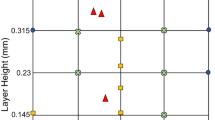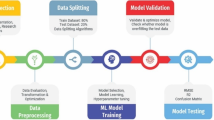Abstract
Manufacturing forecast problems have been widely discussed in recent years, where more accurate predictions could reduce the overall manufacturing costs. This study uses the case of ensuring the heights of thin film transistor–liquid crystal display photo-spacers. It is a small sample size prediction problem, because the data available for analysis is limited on the manufacturing lines. A new approach is developed to deal with this problem, which involves three steps. The first step is using K-means clustering to separate data into K clusters, while the second step is to compute the possibility through the fuzzy membership function in each cluster for attribute extension. The last step is to put the data with new generate attributes into a backpropagation neural network (BPNN) machine learning algorithm. Two performance evaluation methods, cross-validation and data specification testing, are selected to compare the proposed method with three popular prediction models: linear regression, support vector machine for regression (SVR), and BPNN. The results show that the proposed method outperforms the others with regard to the total errors, mean square error, and standard deviation.
Similar content being viewed by others
References
Ali S., Smith-Miles K. A. (2006) A meta-learning approach to automatic kernel selection for support vector machines. Neurocomputing 70(1–3): 173–186
Amari S. I., Wu S. (1999) Improving support vector machine classifiers by modifying kernel functions. Neural Networks 12(6): 783–789
Braha D., Elovici Y., Last M. (2007) Theory of actionable data mining with application to semiconductor manufacturing control. International Journal of Production Research 45(13): 3059–3084
Carrizosa E., Martin-Barragan B., Morales D.R. (2010) Binarized support vector machines. Informs Journal on Computing 22(1): 154–167
Chan K., Kwong C., Tsim Y. (2010) A genetic programming based fuzzy regression approach to modelling manufacturing processes. International Journal of Production Research 48(7): 1967–1982
Chao G. Y., Tsai T. I., Lu T. J., Hsu H. C., Bao B. Y., Wu W. Y. (2011) A new approach to prediction of radiotherapy of bladder cancer cells in small dataset analysis. Expert Systems With Applications 38(7): 7963–7969
Cook D. F., Shannon R. E. (1991) A sensitivity analysis of a back-propagation neural network for manufacturing process parameters. Journal of Intelligent Manufacturing 2(3): 155–163
Haykin S. (1994) Neural networks: A comprehensive foundation. Prentice Hall PTR, Upper Saddle River, NJ, USA
Huang C., Moraga C. (2004) A diffusion-neural-network for learning from small samples. International Journal of Approximate Reasoning 35(2): 137–161
Jain A. K. (2010) Data clustering: 50 years beyond K-means. Pattern Recognition Letters 31(8): 651–666
Jain A. K., Dubes R. C. (1988) Algorithms for clustering data. Prentice Hall, Englewood Cliffs, NJ, USA
Khan, N., Ksantini, R., Ahmad, I., & Boufama, B. (2011). A novel SVM+ NDA model for classification with an application to face recognition. Pattern Recognition, doi:10.1016/j.patcog.2011.05.004.
Kumar N., Kennedy K., Gildersleeve K., Abelson R., Mastrangelo C., Montgomery D. (2006) A review of yield modelling techniques for semiconductor manufacturing. International Journal of Production Research 44(23): 5019–5036
Li D. C., Chen L. S., Lin Y. S. (2003) Using functional virtual population as assistance to learn scheduling knowledge in dynamic manufacturing environments. International Journal of Production Research 41(17): 4011–4024
Li, D. C., Chen, W. C., Liu, C. W., & Lin, Y. S. (2011). A non-linear quality improvement model using SVR for manufacturing TFT–LCDs. Journal of Intelligent Manufacturing, doi:10.1007/s10845-010-0440-1.
Li, D. C., Fang, Y. H., Liu, C. W., & Juang, C. (2010). Using past manufacturing experience to assist building the yield forecast model for new manufacturing processes. Journal of Intelligent Manufacturing, doi:10.1007/s10845-010-0442-z.
Li D. C., Liu C. W. (2009) A neural network weight determination model designed uniquely for small data set learning. Expert Systems With Applications 36(6): 9853–9858
Li, D. C., & Liu, C. (2010). Extending attribute information for small data set classification. IEEE Transactions on Knowledge and Data Engineering, doi:10.1109/TKDE.2010.254.
Li D. C., Wu C. S., Tsai T. I., Lina Y. S. (2007) Using mega-trend-diffusion and artificial samples in small data set learning for early flexible manufacturing system scheduling knowledge. Computers & Operations Research 34(4): 966–982
Li D. C., Yeh C. W. (2008) A non-parametric learning algorithm for small manufacturing data sets. Expert Systems With Applications 34(1): 391–398
Li T. S., Huang C. L., Wu Z. Y. (2006) Data mining using genetic programming for construction of a semiconductor manufacturing yield rate prediction system. Journal of Intelligent Manufacturing 17(3): 355–361
Liao T. W. (2011) Diagnosis of bladder cancers with small sample size via feature selection. Expert Systems With Applications 38(4): 4649–4654
Niyogi P., Girosi F., Poggio T. (1998) Incorporating prior information in machine learning by creating virtual examples. Proceedings of the IEEE 86(11): 2196–2209
Radhakrishnan T., Nandan U. (2005) Milling force prediction using regression and neural networks. Journal of Intelligent Manufacturing 16(1): 93–102
Sanchez A., David V. (2003) Advanced support vector machines and kernel methods. Neurocomputing 55(1–2): 5–20
Shin C. K., Park S. C. (2000) A machine learning approach to yield management in semiconductor manufacturing. International Journal of Production Research 38(17): 4261–4271
Vapnik V. N. (1995) The nature of statistical learning theory. Springer, New York, NY
Witten I.H., Frank E. (2005) Data mining: Practical machine learning tools and techniques. Morgan Kaufmann, San Francisco
Wu L., Zhang J. (2010) Fuzzy neural network based yield prediction model for semiconductor manufacturing system. International Journal of Production Research 48(11): 3225–3243
Yang J., Yu X., Xie Z. Q., Zhang J. P. (2011) A novel virtual sample generation method based on Gaussian distribution. Knowledge-Based Systems 24(6): 740–748
Yang T., Kecman V. (2009) Adaptive local hyperplane algorithm for learning small medical data sets. Expert Systems 26(4): 355–359
Zorriassatine F., Tannock J. (1998) A review of neural networks for statistical process control. Journal of Intelligent Manufacturing 9(3): 209–224
Author information
Authors and Affiliations
Corresponding author
Rights and permissions
About this article
Cite this article
Li, DC., Chang, CC., Liu, CW. et al. A new approach for manufacturing forecast problems with insufficient data: the case of TFT–LCDs. J Intell Manuf 24, 225–233 (2013). https://doi.org/10.1007/s10845-011-0577-6
Received:
Accepted:
Published:
Issue Date:
DOI: https://doi.org/10.1007/s10845-011-0577-6




